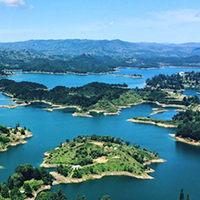The first floristic study of freshwater dinoflagellates (Dinophyceae) in Colombia

All claims expressed in this article are solely those of the authors and do not necessarily represent those of their affiliated organizations, or those of the publisher, the editors and the reviewers. Any product that may be evaluated in this article or claim that may be made by its manufacturer is not guaranteed or endorsed by the publisher.
Authors
The first comprehensive study of dinoflagellate flora and their related environmental variables in reservoirs, swamps, and an insular lake of Colombia is presented. Fourteen Colombian water bodies were assessed. In each, water temperature, electric conductivity, oxygen saturation, turbidity, and apparent color were the physical and chemical variables measured. Twelve dinoflagellate taxa were recorded, indicating a considerable richness compared to similar surveys. Ensembles recovered showed a spatial structuration mediated by the type of the water bodies (reservoirs and swamps); environmental variables and species richness explained equally the differences among the water bodies. The dinoflagellate flora showed altitudinal segregation, with intermediate altitude systems displaying the highest richness values. A brief discussion about the geographical distribution of the species collected is offered. The study contributes to the knowledge of the ecological aspects of dinoflagellate flora and outlines preliminary biodiversity tendencies of ensembles in tropical water systems.
Edited by
Andras Abonyi, MTA Centre for Ecological Research, Institute of Ecology and Botany, Vácrátót, HungaryHow to Cite

This work is licensed under a Creative Commons Attribution-NonCommercial 4.0 International License.






